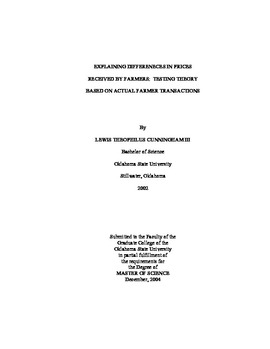| dc.contributor.advisor | Brorsen, B. Wade | |
| dc.contributor.author | Cunningham, Lewis Theophilus, III | |
| dc.date.accessioned | 2014-04-15T19:52:34Z | |
| dc.date.available | 2014-04-15T19:52:34Z | |
| dc.date.issued | 2004-12-01 | |
| dc.identifier.uri | https://hdl.handle.net/11244/8668 | |
| dc.description.abstract | Years of research have been dedicated to determining the best time for producers to sell their commodities. Researchers have developed basis models, market efficiency tests, hedging/risk models, price forecasting models, and many other models in an attempt to help producers. There is a vast amount of material on how economists believe that a rational producer should act and react in the market place. However, there is little research on how producers actually sell commodities. Essay I (Cash Marketing Styles and Performance Persistence of Wheat Producers) first measures the extent to which producers display an active or mechanical marketing style using individual farmer sales. Next, tests of performance persistence are conducted to determine if there is any advantage to an active marketing style. Recent research in behavioral finance has found differences between men and women and how they make marketing decisions. Past research in agricultural economics suggests the possibility that women may be better marketers. Essay II (Gender Differences in Marketing Styles) uses actual farmer transactions to measure differences between how and when men and women market their wheat. The results for Essay I show that southern Oklahoma wheat producers tend to have a mechanical marketing style, while at other locations producers appear to have a more active style. The results show no evidence of performance persistence and thus suggest that there is no advantage to using an active marketing style. The results for Essay II show that women sell later in the marketing year and mostly sell all their grain at one time. While there is no direct effect of gender on price received, by storing longer women are receiving a slightly lower net price. Thus, the research does not support the hypothesis that women are better marketers. | |
| dc.format | application/pdf | |
| dc.language | en_US | |
| dc.publisher | Oklahoma State University | |
| dc.rights | Copyright is held by the author who has granted the Oklahoma State University Library the non-exclusive right to share this material in its institutional repository. Contact Digital Library Services at lib-dls@okstate.edu or 405-744-9161 for the permission policy on the use, reproduction or distribution of this material. | |
| dc.title | Explaining Differencesin Prices Received by Farmers: Testing Theory Based on Actual Farmer Transactions | |
| dc.type | text | |
| dc.contributor.committeeMember | Anderson, Kim Barry | |
| dc.contributor.committeeMember | Norwood, Franklyn Bailey | |
| osu.filename | CunninghamIII_okstate_0664M_1085.pdf | |
| osu.college | Agricultural Sciences and Natural Resources | |
| osu.accesstype | Open Access | |
| dc.description.department | Department of Agricultural Economics | |
| dc.type.genre | Thesis | |
| dc.subject.keywords | behavioral finance | |
| dc.subject.keywords | cash markets | |
| dc.subject.keywords | gender | |
| dc.subject.keywords | marketing styles | |
| dc.subject.keywords | performance persistence | |
| dc.subject.keywords | wheat | |
